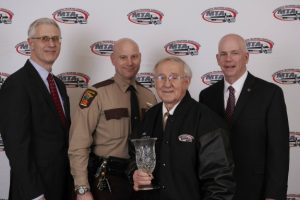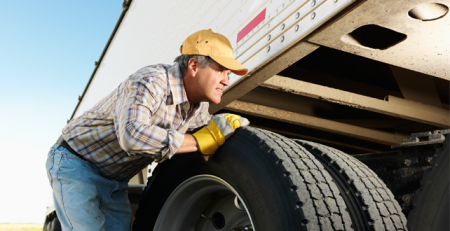Downspeeding Engines Make It Easy For Drivers To Enjoy The Ride While Saving On Fuel
 The vast majority of CDL holders today came into our industry learning certain fundamentals about operating a large truck. Starting in the late 1970s, we learned that if you drove much above 1800 rpm, (2100 in some engines) you were up against the governor and you had to either shift up or back off the throttle. At the lower end, there was a change from earlier practice. The power band was no longer between 1800 and 2100 rpm, and you no longer had to wind up the engine and drive at maximum revs.
The vast majority of CDL holders today came into our industry learning certain fundamentals about operating a large truck. Starting in the late 1970s, we learned that if you drove much above 1800 rpm, (2100 in some engines) you were up against the governor and you had to either shift up or back off the throttle. At the lower end, there was a change from earlier practice. The power band was no longer between 1800 and 2100 rpm, and you no longer had to wind up the engine and drive at maximum revs.
Peak horsepower is still achieved at the high end of the rpm range, and peak torque at the low end, but at lower revs, often at 1200. By cruising near the midpoint, between 1500 and 1600 rpm, you could stay in gear longer as terrain changed. That was different from the previous, underpowered generation of engines that developed peak power at 2100 rpm and peak torque just below it, at 1800. With their very narrow power range, the drivers of the day were constantly shifting gears, and trucks would have to slow way down climbing hills that we might take today by just switching out of overdrive.
But even by 1980, if you let rpm drop below 1200, you experienced severe lugging. The engine would buck and shudder, and if you didn’t downshift soon enough, it would stall. Still, it was a revolution in driving style made possible by engines with wider and slower power bands.
Today, after about 40 years, we are facing another revolution in driving style. This time, it has a name: downspeeding.
Simply put, downspeeding is operating an engine at a slower speed in order to save fuel. The less work an engine has to do to provide a given result — moving the truck from point A to point B in a given period of time — the less fuel it will use.
Notice the part about the given period of time. It’s not about slowing down. You still have schedules to meet and deliveries to make. It’s about having the engine run slower while doing its work. That involves the engine, the transmission and the entire drivetrain.
A slower engine
Forty years ago, fuel injection was controlled by a plunger driven by a cam lobe. For every rotation of the camshaft, each fuel injector squirted once and a given amount of fuel went into the combustion chamber, filled with heated, compressed intake air, and ignition occurred. Injection pressures were about 2000 to 3000 psi. Combustion was not very efficient.
As we evolved into the era of electronically controlled engines, engineers developed indirect means to pressurize the fuel. Injection pressures grew to 30,000 psi, 40,000 psi and beyond. Electronic timing controls allowed engineers to create multiple injections per stroke, timed for maximum fuel efficiency. Today’s latest engines are able to produce peak torque at speeds as low as 1000 rpm, and to maintain enough torque to keep a loaded truck rolling at clutch engagement speed of 800 rpm or less. That’s where downspeeding comes in.
There are numerous advantages to running engines slower. First, it takes less energy to turn the engine’s moving parts. Pistons, rings, the crankshaft and camshafts, gears and timing chains, valves and all the driver accessories all have mass, and it takes energy to move mass. Slow the movement and save the energy. Second, heat transfers more slowly between two masses when they are moving slower in relation to each other. By reducing heat transfer to the block and coolant, less energy is wasted.
Engineers estimate that as much as 60 percent of energy losses from line-haul or long-haul trucks come from their engines. Downspeeding addresses many of these losses. The engineers can make their engines run slower, but if that was all they did, we’d just have slower running trucks.
Drivetrains
There was a time when a 4.56:1 or higher ratio at the drive axles was normal for on-highway vehicles. That’s the number of turns the drive shaft makes for one turn of the drive axle. It’s also the amount that the driving torque is multiplied at the rear end. With little torque, trucks needed more revolutions and more multiplication.
In the 1990s, the Technology Maintenance Council (TMC) promoted the “Gear fast. Run slow.” concept. The idea was to specify drive gears in the 3.55:1 to 3.90:1 range while keeping engine rpm below 1500 at cruise. As electronics allowed engines to be more flexible, rear axles dropped below 3.55, often down to the 3.20s. Some of the benefit was lost when state speed limits increased, but at cruise speeds between 62 and 68 mph, 1450 engine rpm was generally accepted as a compromise between reasonable fuel economy, engine derivability and component reliability.
It would appear logical that the next step in downspeeding would be to specify faster (lower numerical ratio) drive axles. But there’s a problem. As you slow the engine down, you cross a threshold where torque must increase to the point that gears, especially gear teeth, must be made far more massive. To accommodate today’s high torque demands with fewer and fewer gear teeth, each tooth must be made stronger and longer. Ring gears must be made larger, and housings must be made big enough for the increased sizes.
It’s not just drive axles that must grow. Universal joints and drive shafts must be sized to withstand the higher torque. For a typical big bore diesel, when cruise speed drops from today’s 1450 rpm to tomorrow’s 1125 rpm, torque loads through the drivetrain increase by 57 percent. According to Dana Commercial Vehicle
Driving Technologies, the increased torque places added stress on the drivetrain, including the axle, driveshaft and inter-axle driveshaft. The useful life of all components is greatly reduced, especially U-joints.
Transmissions
Today’s automated manual transmissions (AMTs) have come a long way since Eaton introduced the Auto Shift and Meritor marketed ZF’s Freedom Line. The latest AMTs sense engine load, grade, truck weight and a host of available sensor inputs that help them predict gearing needs and make decisions to shift or stay in a given gear. These will be necessary for a smoother operation of the transmission with benefits for downsped engines and their driveline components.
Why undergo this latest evolution in engine speeds? Because for every 100 rpm lower engine speed, fuel economy improves by about 1 percent. And with diesel hovering around $3.00 a gallon, savings can still be significant.
If you drive 10,000 miles a month and you’re in the market for a new truck, the savings between one geared to cruise at 1450 rpm and another at 1150 rpm, assuming 7 mpg in real-world driving, can be $1,600 annually. Even if you can achieve 9 mpg with a standard engine, downspeeding can still save more than $1,200. Those are worthwhile numbers.
Source: http://roadking.com/trucks/downspeeding-engines-make-easy-drivers-enjoy-ride-saving-fuel/










